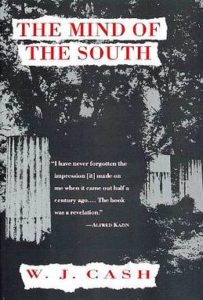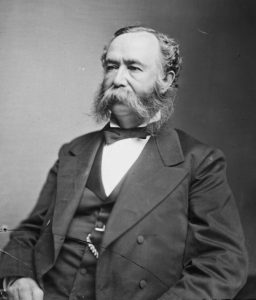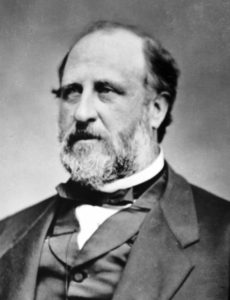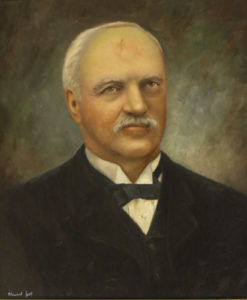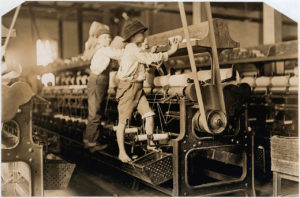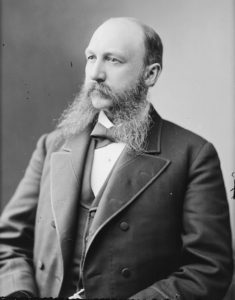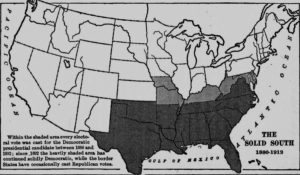Redeemer Policy Systems
The “Radical Republican” coalition Reconstruction policy systems described in the last module upended the antebellum policy system, but paid an exceedingly high cost by generating a massive political blow back which was the driving force in ending Reconstruction by re-admittance to the Union as soon as possible. “Redeemers” were the coalition that congealed to secure at all costs a “redemption” which constituted nothing less than the complete removal of Reconstruction and governance by blacks, northern carpetbaggers, opportunistic Whigs and southern scalawags. They earnestly wanted a “return to normalcy”–control of the South by southerners–as white southerners defined “southern”.
Redemption was administered through a partisan realignment accomplished by a merger of the old Democratic Party with Southern Whig Party. The Whigs merged into a what became the single-dominant political party–the Democratic Party. Every state in the Confederacy participated in this Redeemer-Redemption merger, producing the famous Solid South. The unified Democratic Party control of all southern states was, in function at least, if not in intent, a solid front of the former-Confederacy in Congress and in national affairs against the Union and northern Civil War victors–chiefly housed in the Radical Republican wing, but, as southern Democrats would later discover, housed also in northern Democratic Party as well.
In any case, Redeemers did not intend to conduct an antebellum economic and political restoration. Redeemer policy systems did not “double-down” on antebellum agricultural-plantation-export economy, but, to the contrary, increased the legitimacy/influence of industrialization proponents, intent on diversifying the southern economic base and advancing its urbanization. Simultaneously, Redeemers intended to rebuild plantations, maintain agriculture and continue a low-wage, export-based (primarily cotton) primary economic base. Each element within the Redeemer coalition preferred either agriculture or industrialization, but both were determined to work things out so that both would be accomplished.
This is the South’s “Divided Mind” in which planters accepted a level of industrialization helpful or necessary to rebuild the plantation, the export economy, and to create wealth, allied with industrialists, called the New Southerners, as co-equals in the policy process, although the strength of each varied state by state, and over time. Because planters were more widely dispersed through the South than New Southern industrialists, the aggregate policy of the Solid South preferenced planters, and the Deep South cotton states. In the 1870’s and 1880’s Mississippi was the heart of the Deep South. Atlanta, the coastal states (Virginia, North Carolina, Georgia and South Carolina), and Tennessee the heart of the New South.
If the reader hasn’t already noticed, post-1875 American ED was again “divided” into (at least) two regional groupings each pursuing their defined economic objectives, as designed, approved and implemented by quite distinguishable state and local policy systems. As we shall see in Theme 5, Gilded Age northern economic development differed sharply in nature from that pursued by southern Redeemer policy systems. As we shall see, ED in the North was mostly “reactive”, coping in various ways/strategies (including Community Development) with an almost spontaneous and unstoppable industrial economic growth (and immigrant-induced political change). Southern ED was in another place entirely. In the North, the post-1875 years are frequently called “the Gilded Age”; in the South, “Redeemer”.
In the South, borne of necessity, of economic collapse and desperation, Redeemer ED was “formative”, creating from scratch plantations, agriculture, industry and commerce–and urban centers–to secure prosperity through economic diversification and to overcome the industrial and innovation time lag created by the northern industrial head-start. That head start threatened the South’s economic autonomy, and potentially could transform it into a mere colony of an increasingly hegemonic North. The goal of industrial-focused New Southerners was never to displace the primacy of agriculture, nor was it to “steal” northern industry. Rather southern ED would “balance agriculture with industry”, an industry created by scratch by hook or crook, including southern startups, southern investment and northern imports of capital and firms where necessary.
Political Structures of the 19th Century Redeemer Policy System
In its earliest years (1870’s) Redeemers, upon termination of Reconstruction policy systems, shared a consensus on two principal goals: effective disenfranchisement of the Black, and elimination of foreign occupation (Northern political control) coupled with industrialization to lessen the North’s economic control). The Democratic Party, the opponent of the Republican Party which was identified with Reconstruction and all its miseries, Black enfranchisement, and the Civil War defeat legacy, was their chosen vehicle to operate the Solid South’s state and local policy systems. This would be the South’s equivalent to the North’s ethnic-based political machine–with which northern Gilded Age urban policy systems would do war.
Two change-agents logically could be employed: (1) convert the Democratic Party into the Redeemer political vehicle. First, used in Virginia and North Carolina for example, was to centralize Democratic Party hegemony by creating a state-level “executive committee” composed of the principal regional “bosses”. The workhorse was the county level “ring”, later to be called the “courthouse gang”–gerrymandered county boundaries ensured whites outnumbered Black voters; (2) along with a governmental process incorporated into state constitutions which used either the governor (Florida and Louisiana) or the legislature to enforce party decisions into governmental structures. For example, Virginia in 1876 approved the County Government Act in which the state legislature appointed the justices of each county. The justices would then “elect” the commissioners of each county–making county government subservient and a tool of its state legislators.
Off to the side, the Democratic Party executive committee facilitated its election of a county chairman, who then was empowered to nominate local judges, and the slew of county-level officials, as well as unduly influence the nomination to state legislature, and to municipal offices. Obviously, the latter was less effective in larger cities, which generally formed their own “ring”. In a one-party system, where the other party chronically was the loser, this meant Redeemer policy systems were “informally-Leninist” and less “democratic” than is commonly recognized today.
The policy produced from these systems therefore cannot be meaningfully compared to policy developed from a two-party competitive system–which, despite its ethnic machine imperfections-was more common in the North. Certainly one major distinction was that northern machines encouraged and integrated its voters into the policy system, while southern Redeemer systems systematically disenfranchised Black voters, and as we shall discover rural Republican white voters as well.
As we have suggested, the awkward Redeemer alliance of agrarian planters and New South/Whig industrial elites had, in effect, installed a less-than-democratic policy system through which they could implement their agreed-upon policies, including, of course, ED. To maintain some perspective, the period in which these political “structures” were approved or evolved (1873-78), overlapped with the trials of Boss Tweed–to be discussed in Theme 5. Nineteenth Century American policy systems were by no means mirror images of 2018 American policy systems. Redeemer policy systems were a political realignment of conservative and “liberal” elites. –hence the tension implied in our “Divided Mind”.
Nineteenth Century Redeemers were an awkward “grand coalition” of elites, composed as they were of the economically-challenged planter class (strongest in Deep South Cotton-Belt states) former Whigs (stronger in border states/Appalachian highland geographies), and an aspirational-entrepreneurial rising urban commercial/industrial class. Redeemers constituted an electoral minority, however economically and politically powerful they might have been. The Divided Mind tension could, and later did prove troublesome, but the two worked out their issues (helped along by continuous independent/populist insurgency. As Woodward observed:
planter and the industrialist Redeemers were able to compose their differences amicably and rule by coalition … planters [however merged] with the new [emerging] middle class [by allying with] supply merchants [local commercial business]. And finally, in some states when the major offices were held by industrialists, the disproportionate voting strength of the Black Belt gave landed interests a significant veto power. Until the end of the [1880’s], any insurgency of lower-class whites [populist] usually enabled the dominant industrial Redeemers to whip the landed interests in line [1]
African-Americans were the clear loser in this transition from Reconstruction to Redemption, but perhaps surprisingly, so was the white yeoman (Scots-Irish) farmer. Not surprisingly, the awkward elite coalition faced encountered turbulence from these folk–blacks, as we shall see, caught in the cross-hairs in any case, probably were more fearful of yeoman whites, and subjected to “plantation paternalism” so accordingly tilted toward Redeemers.
As early as 1878 (two years after Reconstruction was formally over), an “independent” movement manifested itself, then in the early 1890’s a Populist Movement and the Populist Part exerted a profound influence on Redeemer politics and policy. At this point we content ourselves with the observation that the Redeemer coalition did not enjoy undisputed power for more than a handful of years before independents and populists complicated matters. Redeemers also were their own worst enemy. Their initial unimpeachable honesty broke down in the face of a its undemocratic single-party Democratic governance. Party monopolies tend in short order to offer “opportunities” which its members cannot turn down. Through the 1880’s especially, most Redeemer states were wracked by Redeemer scandals, usually of little monetary consequence, but at considerable odds with the their “rule by the best” legitimacy.
“Retrenchment”
Florida’s Governor Drew defined “retrenchment” as “spending nothing unless absolutely necessary“. In his 1877 address to the state legislature he asserted that “government will be the most highly esteemed that gives the greatest protection to the taxpayer”. Shared by planter and New South alike Redeemers saw themselves “as champions of the property owner against the propertyless and allegedly untaxed masses”. New South editor, Henry Watterson proclaimed that “Intelligence and property must rule over imbecility and pauperism”. [2]
The motivation that produced retrenchment, free government, limited services and low tax were several. Three stand out: (1) the Reconstruction fiscal legacy left to Redeemers to repair created very tight budgets with funds disproportionately paying debt interest and guarantees; (2) in desperate times no one wanted higher taxes, and low taxes were major priorities for both planters and New Southerners; and (3) it worked electorally, and provided sufficient support to sustain the Redeemer policy system.
Redeemers usually ensured the durability of limited spending and low taxes by constructing new state constitutions with provisions that seriously constrained debt, high taxes and state-level expenditures. After Redemption new constitutions were adopted by Tennessee and Virginia (1870), Arkansas (1874, Alabama (1875), North Carolina and Texas (1876), Georgia (1877)/ and Louisiana 1879. In general, these constitutions limited the legislature’s ability to bypass or deviate from “retrenchment”, and in several instances (Louisiana in particular) was proscribed from regulating several sectors and businesses [3]. Northern state legislatures as we shall see, while not without their quirks and anti-Big City biases, were much more willing, often for the worst of reasons, to encourage local debt-risk, and to devise recourse through bypass mechanisms and hybrid EDOs.
Cheap, therefore limited government produced honest government. They coined the expression “free government” to describe the aggregation of these features. Accordingly salaries were cut in half. In the 1880’s only two southern states paid their governors more than $5,000; four paid $3,000. Small bureaucracies became minuscule, or were simply closed. The Texas legislature cut their pay to only $2 per day when (if) the session exceeded sixty days. The results of retrenchment were dramatic. Taxes were radically reduced, state budgets were incredibly low.
Redeemer policy systems highly preferenced business investment, especially by railroads, utilities and insurance companies. Such sectors were granted franchises and exempted them from taxes and/or reduced their assessments far below true value. While not every southern Redeemer state exempted newly-relocated manufacturing, many municipalities and most southern states did. Existing manufacturing was less preferenced.
A typical abatement approved by Mississippi in 1882 abated “machinery and everything in and about a new factory, save railroad capital, to be exempt from all taxation for a period of ten years. In that states during the Redeemer period were not active in pursuing northern firms and more likely to be chasing immigrant and other “people” attraction, the manufacturing abatement is most likely to be intended for whatever manufacturing firms appeared on southern doorsteps. [4]
Limited government necessarily meant limited services, but in the Redeemer policy system service cutbacks was somewhat mitigated by transferring services to local government. When one shifts to total government expenditures (all levels), limited services is less apparent. The Redeemer tax system (poll tax), but property taxes were high–in spite of its propertied constituency.
Public education was the policy area most seriously crippled by Redeemer policy systems–raising the question of why. Fiscal cheapness, and passing the buck to sub-state governments was part of the answer, but there was also considerable public comment by New Southerners and Agrarian planter-types that not a small part of the rational for cutbacks in public education was justified by the needed entry of women and, in this case, children into the workforce–both elements of the Redeemer coalition wanted cheap labor, and that included women and children.
To them anti-low funded k-12 (and university) education was an upside-down non-knowledge-based workforce strategy as well as a way to balance state and local budgets. Often the rhetoric used to justify educational budget reductions was formally linked to the need for economy, but also that young were likely to be more prosperous working than in school. Women and children were regarded as “vital” members of the workforce, and New Southerners strongly advocated they be allow to work in industry and mills. Poverty was an issue, and child/women labor had been commonplace in early northern industrialization and immigrant populations–and in textile mills across the globe. If one could compare the post-Civil War rural South a developing nation, the case might be made that there was a terribly sad, horribly politically-incorrect logic for child labor–a case I do not make, but rather acknowledge.
In any case MED business climate, railroad and manufacturing targeting were clear exceptions to Redeemer retrenchment and limited services. This is owed to New Southerners who hoped and believed that limited, low tax government would stimulate business investment, and attract northern industrial investment–but in these years “stealing companies” was not their intent at this point in time. They wanted to develop southern rail infrastructure and generate northern investment in southern heavy industry and natural resources. Planters, in any case, were at best indifferent to this rationale.
The prime drivers of the Redeemer “retrenchment” business climate were internal, more fiscal and electoral than ED.
An Assessment of 1870-1900 “Redeemer Policy Systems
The Redeemer policy system lasted for more than a generation, and most despicable features were 1890’s Jim Crow laws. Today to the extent we think of 19th Century Redeemer policy systems, we link them with these Jim Crow laws and the apartheid-segregation-disenfranchisement society, politics and economy they created. The first major systematic Jim Crow laws originated as the so-called Mississippi Plan which commenced in 1875–a Second Mississippi Plan was introduced in 1885. Diffusion through the South shortly followed each.
Redeemer, however, useful in some respects, I judge unhelpful in understanding post-Reconstruction ED. The style and substance of Redeemer policy systems differed with each state (and sub-regions), and often major cities, contrasted with the countryside. The nature, structure, processes and composition, never mind policy outputs of each state and local policy system also, despite many commonalities, differed noticeably. As far as ED went, Redeemer ED varied across the South–despite external “smush” analysis which conflated many systems into one horrendous stereotype, that has often saturated our literature, and fueled periodic versions of a “policy” war between the states.
The first task then of this module is to better understand the diversity of Redeemer policy systems that existed in the post-Reconstruction South.
Race and the Class Structure of Post-Reconstruction Southern Policy Systems
Slavery/African-Americans were the key and core element underlying southern policy systems and the critical factor around post-Reconstruction southern policy coalitions. Southern ED, as with most policy areas, could not escape that dynamic. This remained true in 1870 and held up into the 1950’s when it was finally challenged. As V.O. Key observed seventy years later (1949):
In its grand outlines, the politics of the South revolves around the position of the Negro. It is at times interpreted as a politics of cotton, as a politics of free trade, as a politics of agrarian poverty, or as a politics of planter and plutocrat … in the last analysis the major peculiarities of southern politics go back to the Negro …. Yet it is far from the truth to paint a picture of southern politics as being chiefly concerned with the maintenance of the supremacy of white over black … the observer must look more closely to determine which whites and which blacks give southern politics its individuality [5]
Slavery/Race thus is fundamental to the structure of the southern policy system, its policy processes, and therefore to our history of American ED. It can enter into our strategies, programs, and even use of key tools such as eminent domain. I do take Key’s advice, however–that racism is not the entire story–that there is much to be learned in understanding other factors which played a significant role in the making of ED policy.
For many discussion of Redeemer policy systems starts and ends with its dominant plantation-planter class. For them, as evidenced by Scarlett O’Hara and her struggles to revitalize her plantation, Tara, Reconstruction was hell. No surprise then that the planter/plantation class was the chief driver in all southern Redeemer policy systems. The list of their “woes” was quite long: debt, adverse tax structure designed to break up plantations, loss of workforce, volatile cotton export markets, literal rebuilding of burnt plantation and replacement of equipment and livestock–i.e. the need for new capital which proved quite expensive.
For the planter class, virtually the only organized power structure in the post-Reconstruction South, the decision to return to agriculture, cotton, tobacco or whatever, was their default. So was revitalizing the plantation which was more than just a big farm to a culture that prided itself as descended from the Royalist Cavaliers of England. The choice of agriculture was less of a decision for the planter class, than a simple return to a way of life lost as a consequence of the war. To them the plantation was a way of life, not just a unit of agricultural production.
Redeemers over a generation fabricated a new sustainable 20th Century plantation system (think of Tennessee Williams’ “Big Daddy”, a Mississippi delta cotton plantation owner). They did this largely by establishing a sharecropping (land tenancy) subsistence system (including whites and blacks). Sharecropping cemented in place a rural low-wage, low service socio-political system that perpetuated southern poverty, inhibited innovation and agricultural mechanization, and did little to advantage cotton exports in an increasingly competitive global market.
Sharecropping incorporated the lesser known “credit-lien” finance system which instead of banks supplying loans, local commercial merchants extended credit to subsidize seed, food, clothes, and equipment to the sharecropper for a percent of the crop. They solidified their plantation “business plan” and thereby locked into political and social place the cheap, subservient agricultural working class that, depending on the location, was composed of both former yeoman white farmers, and Freedmen blacks.
Freedmen Blacks and Yeomen White “Farmers”.
As for Freedmen Blacks and white Yeoman farmers, the Redeemer policy system was certainly much worse economically for the white yeoman, and not much better for the Freedman Black when compared to slavery. Jim Crow effectively disenfranchised African-Americans, and sharecropping economically disenfranchised both classes. Gone, almost entirely, was the antebellum definition of the “deference” culture, in which planters acceded to yeoman participation in policy-making, opening access and even a degree of status in both state and local policy systems that conferred dignity and legitimized aspirational hope for yeoman class mobility.
Predominately rural in 1870, these two classes constituted the new plantation’s proletariat. In those geographies where the plantation could not profitably function, these two classes quickly devolved into “lumpen-proletariat”, probably the poorest segment of American society in the 19th Century. This sharecropper “restructured plantation system” produced a post-Reconstruction “yeoman” way of life described in Erskine Caldwell’s 1932 classic, Tobacco Road.
This yeoman political, social and economic way of life, a noticeable departure from that enjoyed in the antebellum Deep South, but also importantly exposed the weakness of agriculture as an economic growth machine in an industrial age. Agriculture by this point had become a mere “industry-sector”, not a way of life. As an industry-sector it experienced a profit life-cycle that was remarkably similar to that manufacturing sectors would start to experience a half-century (or so) later. Southern export agriculture was mature, looking for ways to minimize costs–and that did little or nothing for the agricultural working class, either African-American or white yeoman. While it is not discussed in Theme 3, the Redeemer South will often be ground zero for the 1880-90’s Populist Movement. The overlap of Scots-Irish Highland-resident geographies with the strength of the southern populist movement is quite notable [6].
At this point, having dispensed with planters, African-Americans, and white yeomen, the reader might logically expect consideration of the business community (small business, commercial and industrial leaders). After all, my model reserves for them a special role in the formulation and implementation of MED and CD policy. Be patient. The early years of post-Reconstruction is not the time.
No surprise then in the future we shall talk about southern urbanization. No surprise that between 1870 and 1900, net out-migration from the nine states of the east of the Mississippi Confederacy totaled some 1.3 million, 58% percent of whom were white. During the same period Arkansas, Texas and Oklahoma enjoyed a net gain of nearly 1.2 million, 85% of whom were white [7]. If I may hazard a guess, Scots-Irish again had taken their recourse to decline and depression by picking up and moving on. I would also suggest the dynamic of cotton land depletion had not abated, and that agricultural migration into new lands would result, until the suitability of lands for sustained agriculture changed the character of that movement–think the 1930’s Dust Bowl, and Grapes of Wrath.
In the post-Reconstruction aftermath, each southern state evolved its own “one-party (Democratic)” policy system, with Republicans a permanent minority. A one party “Solid South” accordingly emerged, dominated state/local policy-making, and eventually, through seniority, accumulated a power base in the U.S. Senate and House. Up until World War I, southern Democrats were labeled as “Bourbon Democrats (for most of his non-presidential life Woodrow Wilson was viewed as such).
In any case the southern political configuration contrasted with the North, where there was more two-party competition, with Republicans generally proving more equal than Democrats, but the latter often able to be a meaningful element of local policy systems. Southern “machine” politics, absent significant immigrant ethnic populations, turned to blacks instead, as Memphis and Knoxville support. In any case, as we shall discover through our history, one-party policy systems can exert a very distinctive and impactful (negative) influence on MED/CD policy-making.
Pre-1910 municipal and county southern government was home-bred Jeffersonian/Jacksonian weak mayor/executive. Participation in policy-making limited to planter/service sector and a few New South business elites. With little bureaucratic capacity or professionalism, this form of government fit an elite-dominated agricultural economic system. At the state-level (as we shall see in later modules) low taxes and limited services were its chief policy goals. By no means were low taxes/low services purely an economic development strategy—it reflected the natural (cultural) tendencies of those involved in policy-making.
Generally dominant in state policy systems especially, planter redeemers could be a substantial barrier to urban/industrial economic development. While they never totally denied the South’s need to industrialize and establish a modern transportation system, the debate over the level/intensity of industrialization created a serious split within Redeemer elites after 1900.
The bottom line is that southern post-Reconstruction Redeemer policy systems, both state and local, were not mirror images of those found in the North–or West. Southern policy systems did not resemble those found in Big Cities. Southern MED/CD did what it did in pursuit of its own defined policy goals, and was defined in terms of its own heritages, cultures, and policy systems/processes. Atlanta, Richmond, Houston or whatever southern local policy system the reader chooses was not a warmed-over Chicago, New York City or Boston–no matter how much the EDOs and strategies possessed the same name. Whatever else it was, Redeemer policy systems provided a measure of continuity to the antebellum/Early Republic autonomous evolution of regional policy systems and distinguishable economic bases.
Footnotes
[1] Woodward, Origins of the New South, p. 21.
[2] Woodward, Origins of the New South,pp. 58-9.
[3] Woodward, Origins of the New South, pp. 65-6.
[4] Woodward, Origins of the New South, p. 60; See James Martin and Glenn Morrow, Taxation of Manufacturing in the South (Literary Licensing, 2013)
[5] V.O. Key, Southern Politics in State and Nation: a New Edition (University of Tennessee Press, 1949, 1984), p. 5.
[6] see Stephen Hahn, the Roots of Southern Populism (Oxford University Press, 2006).
[7] William H. Nicholls, Southern Tradition and Regional Progress (University of North Carolina Press, 1960), pp. 24-5.


